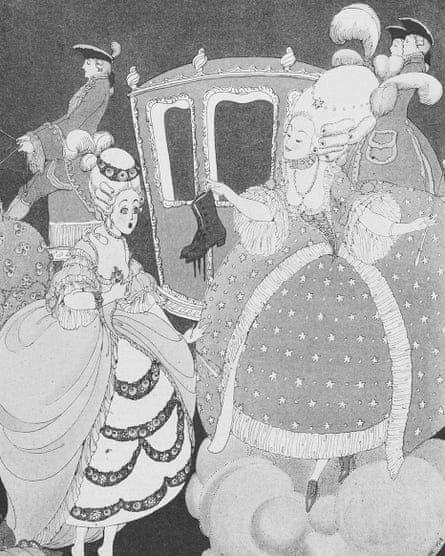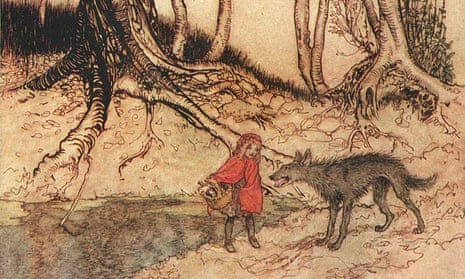From a masochistic, submissive version of Cinderella who is gunning for a prince with a shoe fetish to a prince who “loved in equal measure brunette ladies and blond pages, beautiful statues and heraldic dogs”, a series of 19th-century French fairytales – many of which have never been translated into English before – are due out this week in the book Fairy Tales for the Disillusioned.
The 36 stories are by Charles Baudelaire, Anatole France Guillaume Apollinaire and other writers associated with the French decadent literary movement. Many of them reimagine Charles Perrault’s classic 17th-century fairytales. Each story comes with a twist, from a wolf who is tricked by Red Riding Hood into strangling the girl’s grandmother and is then arrested for being an anarchist (“I did 20 years of hard labour, while the slut inherited her grandmother’s savings”) to a Cinderella keen to be humiliated.
In Claude Cahun’s story Cinderella, the Humble and Haughty Child, written around 1925 and not previously translated into English, the heroine binds her feet in cloth to keep them “small and compact, and sort of stunted”, because “this exquisite and most effective torture fills me with utter satisfaction”. She adores her “deliciously cruel” stepsisters, especially the older one “who despised me so much it thrilled me”. Cahun wrote: “Seeing me always seated in the fireplace’s cinders, whose heat penetrated me delectably (sometimes even burning me), with her sweet, familiar voice, didn’t she call me Cinderass? Never was a word so sweet to my ears.”
Her prince, meanwhile, had a love for women’s shoes. “Touching them, kissing them, letting himself be walked on with their charming heels (pointed heels with a scarlet tint so they looked as if they were splattered with blood) – these were the simple pleasures he’d been looking for since he was a child.”

Publisher Princeton University Press said the “enchanting yet troubling” stories “reflect the concerns and fascinations of a time of great political, social and cultural change”, with themes ranging from gender confusion to the intrusion of the industrial.
According to the book’s editors, Gretchen Schultz and Lewis Seifert, who are professors of French studies at Brown University, hundreds of decadent fairytales were published in France between 1870 and 1914. The stories were aimed at adult readers and often populated by “androgynous, effeminate and Sapphic characters”, such as Renée Vivien’s tale Prince Charming, in which the prince turns out to be a woman (“For the first time since the beginning of the world, the bridegroom was as beautiful as the bride”) and Catulle Mendès’s An Unsuitable Guest, in which the prince asserts that it “was much more entertaining to gather flowers than to kill men”.
“Nearly a century before postmodern fairytales by Margaret Atwood, AS Byatt, Angela Carter and others upend fairytale stereotypes about gender and sexuality, decadent writers created female characters unlike the virginal beauties of the classic tales, and exposed the romantic myths associated with the genre,” the editors write in the book’s introduction. “Mendès’s Beauty refuses the prince’s kiss, preferring her own dreams to the love and riches he offers. And in Willy’s tale [the previously untranslated Fairy Tales for the Disillusioned], the young couple Daphnis and Chloe are dissuaded from marrying each other after a troop of characters out of Perrault convince them not to believe in fairytales.”
Their disillusionment means the pair resolve not to get married, but this does not stop them from consummating their passion. “In fact, they had lost no time during the small hours that night, and Chloé was no longer what one could call a virgin. This tale has no moral,” wrote Willy Pogany in 1894.
Seifert told the Guardian: “What we found particularly fascinating is how this group of fairytales anticipates aspects of what are often called postmodern fairytales by such English-language writers as AS Byatt, Angela Carter, Robert Coover and others,.”
“There’s a similar play with fairytale structures and an ironic distance from fairytale themes and expectations. It’s highly doubtful that the French tales were a direct influence on these writers (except perhaps Anatole France), but the similarities point to the fact that the fairytale invites retellings and specifically retellings that play with its assumptions. This is particularly true of those written primarily for adult readers.
“All this said, the decadent French tales are very much the product of their time, especially in terms of gender politics, so I wouldn’t push the comparison too far,” said Seifert. “Still, the stories complicate common preconceptions about the genre, and show that writers were doing this sort of thing long before our era.”
He speculated that the stories had not previously been translated into English partly because of the market for fairytales in Victorian England was oversaturated, and also because of the “dark and cynical tone of many of the French tales, which contrasts rather sharply with much of what was being written and read on the other side of the Channel”.
Schultz thought they would have more appeal in the modern climate. “There’s a certain appeal today for literature having a cynical edge,” she said. “The theme of disillusionment, at this moment in the US election cycle, is timely. And more broadly, the social and political turmoil at the fin de siècle in France, which contributed to the decadent ethos and its reimagining of classic fairytales, offers some parallels to our world that are worthy of contemplation.”

Comments (…)
Sign in or create your Guardian account to join the discussion